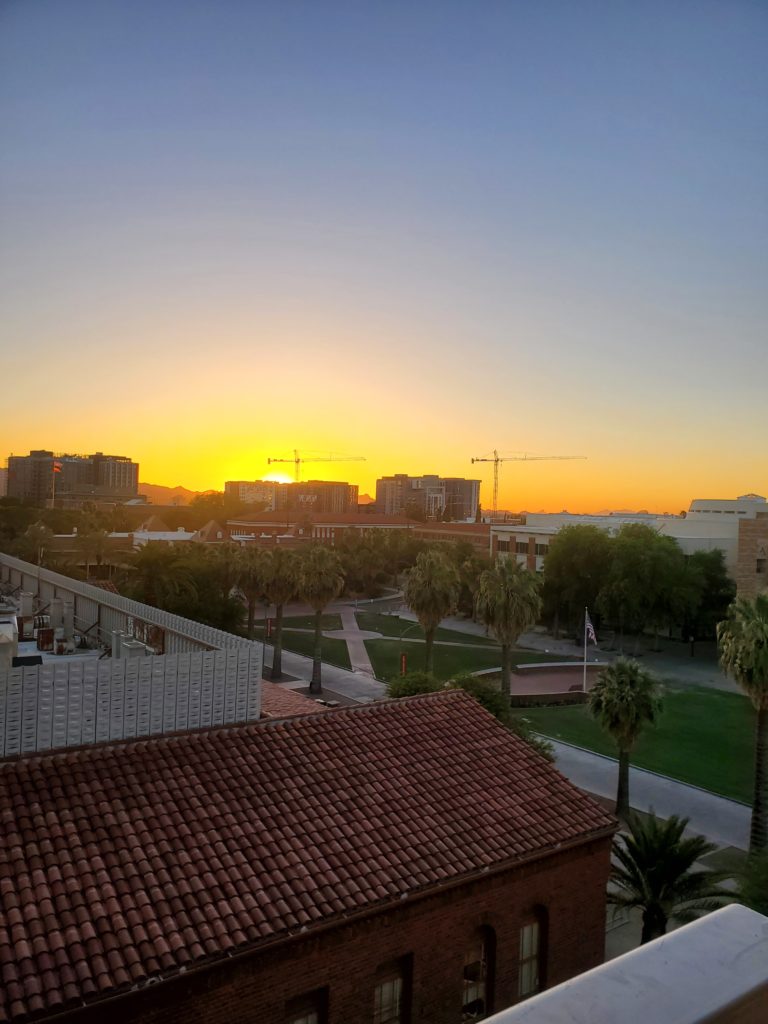During this module our group experienced a variety of different environments. In our trio I tried Katrine’s proposition and Gefsi tried mine. Katrine’s proposal asked us to go on a walk that we had done before and set a 10 minute timer and record what we observed. I chose to go on a walk that I had gone on a lot during the beginning of covid-19. I walked out of my apartment and followed the path to the center of the University of Arizona called “the mall”. The open space is surrounded by buildings and the theater. This is a walk that I would do a lot while talking to my sister. She would call me and then we would walk “together” her in Northern California around her neighborhood and myself, walking on campus. As I walked I went up a staircase of a five story building and watched the sunset. I found a cat that was relaxing on a bench by the theater. It reminded me of Greece because of all of the wild cats that I saw while I was there.
One of the things that I took note of was how empty the campus was and the contrast that it has during the year when everyone is back in town. During the summers they mark off the grassy areas to help with regrowth. This fence made me think of the manicured state of the University as a whole and how kept every space is. I remembered a book that I had read during undergrad called “The World Without Us” by Alan Weisman. In this book Weisman creates a narrative about what the world would look like if humans ceased to exist. The boundaries that are kept would easily be crushed by the nature we work so hard to control. It made me wonder how fast the University would change once the upkeep wasn’t met.
In my own practice I’ve thought about reworking paths and what changes when I take away the external distractions such as talking on the phone or listening to music. Each of these activities helps relieve stress but takes away from personal observation of the place. Taking a step away from my phone even if I wasn’t actively looking at it made me more present in the place.
The act of trading our propositions added to the pedagogical practice because this exercise required each of us to learn more about the others surroundings. In my initial proposal I asked Gefsi to on a a new path looking for cracks in the sidewalk and then take a photo of one of these cracks and invited her to transform it. This proposition was inspired by some recent trips that I had taken. One where someone had covered a crack in the sidewalk with a mirror and the other on a trail at horseshoe canyon. What I learned was that this challenge did not work for Gefsi because the train around her home was tile with very few cracks. This was interesting because I have only grown up with cement sidewalks and therefore had to reflect on how to change the proposition to better fit her environment. We decided to change it and have her look for squares on her walk based off of the photo that she sent. This made the proposition more enjoyable and was better suited for her environment.



Dear Sydney, Thank you for your reflections! I like the attention to the ‘invisible hand’ – to how some places are very carefully ‘kept’, and why that is (and what happens when they are not). Of course there is also the movement (among gardeners etc) to collaborate more with the environments, to work with it and not against (carefully kept lawns would be the no-no, I gather).
The walking together-apart during Covid-19 is an experience we have tried in different ways, for sure! Helene and I have written a chapter about such walks, which will be out soon. To me, it was a nice experience as well, to find new ways of being together and sharing. So that has inspired more work / reflections. I like how everyday experiences and environments, like in Katrine’s proposition to go on a familiar walk and observe in a time slot of 10 minutes, is fully enough to create new work and good reflections!